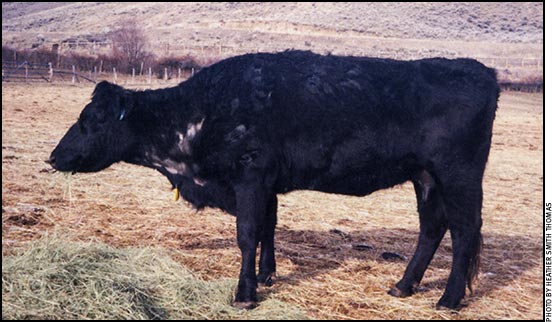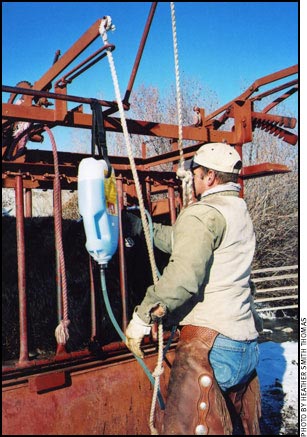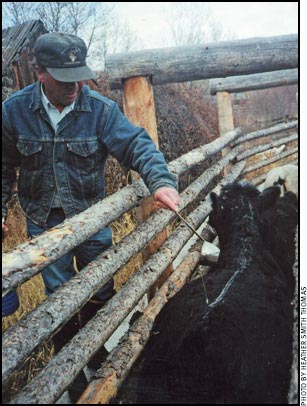
cutline
Controlling Lice
Expert offers tips for choosing the right product to kill lice on cattle.
For long-term lice control, producers need to kill the eggs, as well as adult lice on cattle, and then not re-expose those treated animals to lice.
Larry Hawkins, technical services veterinarian at Bayer, says many products just kill adult lice but don’t affect the eggs. The eggs go ahead and hatch, and 3 weeks later the cattle have lice again. Label directions recommend retreatment in two to three weeks to kill young lice that hatched after the first treatment. Retreatment is necessary to kill those lice before they mature enough to start laying eggs.

cutline
Another problem is inadequate treatment.
“Lice are found on the nose, on the dewlap, in the armpits and groin area where a pour-on product may not reach very well. Lice move around, however, and are likely to come into contact with the pour-on if it was applied all along the back, on the poll and down the face. If we just put the dosage in the middle of the back, it’s a long ways to the nose, brisket or armpits, so some lice may not contact the product,” says Hawkins.
There is one product called Clean-Up™ II Pour-On Insecticide with IGR that kills the eggs, as well as adults.
“It contains an insect growth regulator that has been proven to stop the eggs from maturing and hatching, and also has a pyrethroid that kills adult lice. One treatment takes care of lice,” says Hawkins. If a person won’t have the opportunity to work cattle and treat them again, this is a good product to use.
After a pour-on application of Clean-Up, it takes about two weeks for the sucking lice to die. When cattle are given an injectable product that treats systemically, the sucking lice die quicker because they are getting the product via the blood they are sucking, but the chewing lice do not feed on blood. With a pour-on along the back, it may take some time to spread down through the hair in the oil layer on the skin surface.
Another option is to treat in late fall when preg-checking and vaccinating with a systemic product that will also kill internal parasites, and then use supplemental treatments for later control.

cutline
“In an operation where cows won’t be handled again, producers can hang dust bags or use some other self-treating methods that the cattle can rub on and be treated,” he says.
“When selling seedstock, it’s important to make sure those animals won’t have any lice by sale time. If the sale is in March, sometime in November they should be deloused (so they won’t be rubbing and losing hair during winter). A product like Clean-Up could be helpful in November and then re-applied in early January to be sure there won’t be any lice coming back before the sale,” he says.
“Some producers think that after a treatment all the lice are instantly dead, but it takes a couple weeks in some cases for those lice to all die. They may be impaired and are probably not reproducing, but may be still on the animal,” says Hawkins.
“One study looking at Clean-Up shows that it took 14 to 21 days to eliminate lice, but there was 100% lice kill at Day 60 when the study ended. We get good kill with most products, but if eggs hatch they recontaminate the animal — except with the Clean-Up. That kills the eggs. It can be used at preg-check time in a cow herd, and if we don’t commingle those cattle with untreated animals, they will stay free of lice.”
If you mix cattle you treated 30 days ago with a group of newly treated cattle, the lice may be gone from the first treated group, but they could be re-infested from the recently treated cattle. Some of the lice on the newly treated animals have not yet traveled enough to encounter the insecticide product and may transmit to other cattle if they have close contact.
“They don’t even have to be in the same group; nose-to-nose contact through the fence can be enough to spread lice,” he says.

Editor’s Note: Heather Smith Thomas is a freelance writer and cattlewoman from Salmon, Idaho.






